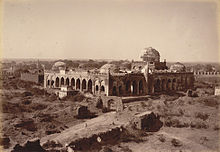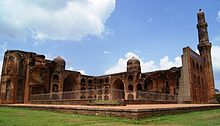Bahmani Kingdom
Bahmani Sultanate | |||||||||||
|---|---|---|---|---|---|---|---|---|---|---|---|
| 1347–1527 | |||||||||||
 Bahmani Sultanate, 1470 CE | |||||||||||
| Capital | Gulbarga (1347–1425) Bidar (1425–1527) | ||||||||||
| Common languages | Persian Language, Urdu, Dakhini, Marathi, Telugu, Kannada | ||||||||||
| Religion | Sunni Islam[1][2] | ||||||||||
| Government | Monarchy | ||||||||||
| Sultan | |||||||||||
• 1347–1358 | Ala-ud-Din Bahman Shah | ||||||||||
• 1525–1527 | Kalim-Allah Shah | ||||||||||
| Historical era | Late Medieval | ||||||||||
• Established | 3 August 1347 | ||||||||||
• Disestablished | 1527 | ||||||||||
| |||||||||||
| Today part of | |||||||||||
| Part of a series on the |
| History of Karnataka |
|---|
 |
The Bahmani Sultanate (also called the Bahmanid Empire or Bahmani Kingdom) was a Muslim state of the Deccan in South India and one of the great medieval Indian kingdoms.[3] Bahmanid Sultanate was the first independent Islamic Kingdom in South India.[4]
The empire was established by Turkic general Ala-ud-Din Bahman Shah after revolting against the Delhi Sultanate of Muhammad bin Tughlaq.[5] Nazir Uddin Ismail Shah who had revolted against the Delhi Sultanate stepped down on that day in favour of Bahman Shah. His revolt was successful, and he established an independent state on the Deccan within the Delhi Sultanate's southern provinces. The Bahmani capital was Ahsanabad (Gulbarga) between 1347 and 1425 when it was moved to Muhammadabad (Bidar). The Bahmani contested the control of the Deccan with the Vijayanagara Empire to the south. The sultanate reached the peak of its power during the vizierate (1466–1481) of Mahmud Gawan. The south Indian Emperor Krishnadevaraya of the Vijayanagara Empire defeated the last remnant of Bahmani Sultanate power after which the Bahmani Sultanate collapsed.[6] After 1518 the sultanate broke up into five states: Nizamshahi of Ahmednagar, Qutb Shahi of Golconda (Hyderabad), Baridshahi of Bidar, Imadshahi of Berar, Adilshahi of Bijapur. They are collectively known as the "Deccan Sultanates".
History
This section needs expansion. You can help by adding to it. (April 2016) |
Culture
Later rulers of the dynasty believed that they descended from Bahman, the mythological figure of Greater Iranian legend and lore. The Bahamani Sultans were patrons of the Persian language, culture and literature, and some members of the dynasty became well-versed in that language and composed its literature in that language.[4]
The craftspersons of Bidar were so famed for their inlay work on copper and silver that it came to be known as Bidri.
List of Bahmani Shahs
| Titular Name | Personal Name | Reign | |
|---|---|---|---|
| Independence from Sultan of Delhi, Muhammad bin Tughlaq. | |||
| Shah شاہ Ala-ud-Din Bahman Shah علاء الدین حسن بہمن شاہ |
Ala-ud-Din Bahman Shah حسن گنگو |
1347–1358 CE | |
| Shah شاہ |
Muhammad Shah Bahmani I محمد شاہ بہمنی |
1358–1375 CE | |
| Shah شاہ Ala-ud-Din Mujahid Shah علاء الدین مجاہد شاہ |
Mujahid Shah Bahmani مجاہد شاہ بہمنی |
1375–1378 CE | |
| Shah شاہ |
Dawood Shah Bahmani داود شاہ بہمنی |
1378 CE | |
| Shah شاہ |
Mahmood Shah Bahmani I محمود شاہ بہمنی |
1378–1397 CE | |
| Shah شاہ |
Ghiyath-ud-din Shah Bahmani عیاث الدین شاہ بہمنی |
1397 CE | |
| Shah شاہ |
Shams-ud-din Shah Bahmani شمس الدین شاہ بہمنی Puppet King Under Lachin Khan Turk |
1397 CE | |
| Shah شاہ Taj-ud-Din Feroze Shah تاج الدین فیروز شاہ |
Feroze Khan فیروز خان |
1397–1422 CE | |
| Shah شاہ |
Ahmed Shah Wali Bahmani احمد شاہ ولی بہمنی |
1422–1436 CE | |
| Shah شاہ Ala-ud-Din Ahmed Shah علاء الدین احمد شاہ |
Ala-ud-Din Ahmed Shah Bahmani علاء الدین احمد شاہ بہمنی |
1436–1458 CE | |
| Shah شاہ Ala-ud-Din Humayun Shah علاء الدین ھمایوں شاہ |
Humayun Shah Zalim Bahmani ھمایوں شاہ ظالم بہمنی |
1458–1461 CE | |
| Shah شاہ |
Nizam Shah Bahmani نظام شاہ بہمنی |
1461–1463 CE | |
| Shah شاہ Muhammad Shah Lashkari محمد شاہ لشکری |
Muhammad Shah Bahmani II محمد شاہ بہمنی دوئم |
1463–1482 CE | |
| Vira Shah ویرا شاہ |
Mahmood Shah Bahmani II محمود شاہ بہمنی دوئم |
1482–1518 CE | |
| Shah شاہ |
Ahmed Shah Bahmani II احمد شاہ بہمنی دوئم Puppet King Under Amir Barid I |
1518–1521 CE | |
| Shah شاہ Ala-ud-Din Shah علاء الدین شاہ |
Ala-ud-Din Shah Bahmani II علاء الدین شاہ بہمنی دوئم Puppet King Under Amir Barid I |
1521–1522 CE | |
| Shah شاہ |
Waliullah Shah Bahmani ولی اللہ شاہ بہمنی Puppet King Under Amir Barid I |
1522–1525 CE | |
| Shah شاہ |
Kaleemullah Shah Bahmani کلیم اللہ شاہ بہمنی Puppet King Under Amir Barid I |
1525–1527 CE | |
| Dissolution of the Sultanate into 5 Kingdoms namely; Bidar Sultanate; Ahmednagar Sultanate; Bijapur Sultanate; Golconda Sultanate and Berar Sultanate. | |||

-
Taj ud-Din Firuz Shah of the Bahmani Sultanate's Firman.
-
Tomb of Ahmad Shah I Wali.

See also
References
- ^ Burjor Avari, Islamic Civilization in South Asia: A History of Muslim Power and Presence in the Indian subcontinent, (Routledge, 2013), 91.
- ^ Farooqui Salma Ahmed, A Comprehensive History of Medieval India: From Twelfth to the Mid-Eighteenth Century, (Dorling Kindersley Pvt. Ltd., 2011), 170.
- ^ "The Five Kingdoms of the Bahmani Sultanate". orbat.com. Retrieved 5 January 2007.
- ^ a b Ansari, N.H. "Bahmanid Dynasty" Archived 19 October 2006 at the Wayback Machine Encyclopaedia Iranica
- ^ Sen, Sailendra (2013). A Textbook of Medieval Indian History. Primus Books. pp. 106–108, 117. ISBN 978-9-38060-734-4.
- ^ Eaton, Richard M. A Social History of the Deccan, 1300-1761: Eight Indian Lives. p. 88.
Further reading
- Avari, Burjor (2013), Islamic Civilization in South Asia: A history of Muslim power and presence in the Indian subcontinent, Routledge, ISBN 978-0-415-58061-8
- Kulke, Hermann; Rothermund, Dietmar (2004), A History of India (Fourth ed.), Routledge
External links
- Chronology of Deccan rulers
- Hameed Akhtar Siddiqui, "History of Bahmanis of Deccan, a Gulbarga Saltanate of India"
- Library of Congress – A Country Study: India


